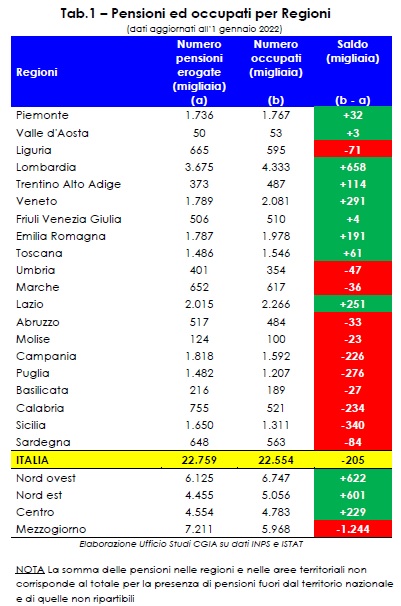Even if only 205 units, at national level the number of pensions paid to Italians (equal to 22 million and 759 thousand checks) exceeded the audience made up of self-employed workers and employees employed in factories, offices and shops (22 million 554 thousand employees). The data refer to 1 January 2022.
The most "unbalanced" situation occurs in the South. If in the Centre-North – with the exceptions of Liguria, Umbria and Marche – active workers, even if only slightly, are more numerous than the pensions paid by INPS and other social security institutions, in the South the overtaking has already taken place: the latter , in fact, exceed the first one million and 244 thousand units. This is stated by the CGIA Research Office.

• The reasons for the gap
In principle, however, the reasons for this gap between workers and the number of pensions must be sought in the strong drop in the birth rate which has been characterizing our country for at least 30 years. The demographic decline, in fact, has helped to reduce the population of working age and to increase the incidence of the over 65s on the overall population. It should be noted that between 2014 and 2022 the Italian population in the most productive age group (25-44 years) decreased by over one million and 360 thousand units (-2,3 percent). As regards the "anomalous" result of the South, it should be noted that, compared to the other geographical divisions of Italy, the number of employed people is significantly lower. Finally, it should be highlighted that the result of this analysis is certainly underdimensioned; we recall, in fact, that in Italy there are just over one million and 700 thousand employed people who, after retiring, continue, on a voluntary basis, to continue to work in full compliance.
• Real estate, transport, fashion and HoReCa are the most penalized sectors
A country with an increasingly elderly population could have serious problems balancing its public finances in the coming decades; especially due to the increase in pension expenditure, pharmaceutical expenditure and expenditure linked to personal care/assistance activities. It should also be noted that with a very widespread presence of over 65s, some important economic sectors could suffer negative repercussions. With a much lower propensity to spend than the younger population, a society made up predominantly of the elderly risks reducing the turnover of the real estate, transport, fashion and hospitality (HoReCa) markets. Conversely, however, the banks could count on some positive effects; with a greater disposition to save, older people should increase the economic size of their deposits, thus making many credit institutions "happy".
• It is difficult to find staff
The progressive aging of the Italian population is also causing another major problem. For some time now, entrepreneurs - not only in the North - have denounced the difficulty of finding highly qualified personnel and/or low-level professionals on the labor market. If for the former the difficulties in finding them are structural due to the misalignment that has arisen in some areas of the country between school and the world of work, for the latter, on the other hand, they are jobs that often our young people, however always less numerous, refuse to occupy and are only partially "covered" by foreigners. A situation that with the upcoming negative economic situation could be destined to return, although in the future the difficulty of matching the demand and supply of labor will remain a difficult matter to solve.
• What to do?
To counter the drop in births and the consequent aging of the population, it is necessary to develop a series of medium-long term interventions. As the Bank of Italy has also had the opportunity to point out, it is essential, in particular, to strengthen policies aimed at demographic growth (e.g. aid to young mothers, families, minors, etc.), lengthen working lives ( at least for people who carry out clerical or intellectual activity), increase female participation in the labor market and, lastly, raise the education level of the workforce which in Italy is still among the lowest in the whole EU.
• In Messina, Lecce and Naples the most "unbalanced" situations
At the territorial level, all the regions of the South have a number of employed persons lower than the number of pension benefits paid out. In absolute terms, the most "unbalanced" situations occur in Campania (balance equal to -226 thousand), Calabria (-234 thousand), Puglia (-276 thousand) and Sicily (-340 thousand). In the Centre-North, on the other hand, only Marche (-36 thousand), Umbria (-47 thousand) and Liguria (-71 thousand) present a critical situation. On the other hand, all the others are of the opposite sign: the most "virtuous" situations - i.e. where active workers are significantly higher than the pensions paid - can be seen in Emilia Romagna (+191 thousand), Veneto (+291 thousand) and Lombardy (+ 658 thousand). Finally, at the provincial level, the most compromised situations recorded in the North concern Biella (-14 thousand), Savona (-18 thousand) and Genoa (-38 thousand). Among the most virtuous realities, however, we see Bergamo (+83 thousand), Brescia (+111 thousand) and Milan (+299 thousand).

In the Centre, the difficulties of Macerata (-14 thousand), Terni (-22 thousand) and Perugia (-24 thousand) stand out, while the result referring to the province of Rome (+275 thousand) stands out from the positive balance. Finally, in the South, the most unbalanced situations concern Palermo (-80 thousand), Reggio Calabria (-86 thousand), Messina (-94 thousand), Lecce (-104 thousand) and Naples (-137 thousand). Of all the 38 provincial realities in the South, only two show a positive balance: they are Ragusa (+8) and Cagliari (+10).
